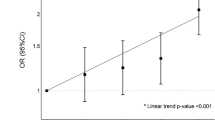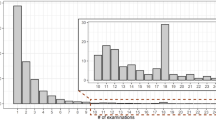Abstract
To elucidate whether uric acid changes in early pregnancy are associated with the development of preeclampsia and their association with preeclampsia-related adverse pregnancy outcomes. We conducted a retrospective cohort study of 4725 singleton pregnant women between January 2017 and July 2019 using propensity score matching. The primary outcome of the cohort was preeclampsia, and the secondary outcomes were preterm delivery, preterm preeclampsia and low birth weight infants. Multivariable predicted marginal proportions from logistic regression models were used to compute adjusted risk ratios. The quantitative-effect relationship between serum uric acid and preeclampsia development was observed by a dose‒response graph, and the effect of serum uric acid on the week of gestation at delivery was assessed using the Kaplan‒Meier method and the log-rank test. The risk of preeclampsia development increased with higher serum uric acid levels. After adjusting for confounders, the risk ratio for the development of preeclampsia with uric acid levels ≥240 µmol/l was 1.25 (95% CI: 0.96–1.65) compared with the group with uric acid levels <240 µmol/l. In the subgroup analysis of KM (Kaplan–Meier) curves, the gestational week at delivery was earlier when uric acid levels ≥240 µmol/l occurred at 8–12 weeks of gestation. Elevated serum uric acid levels before 20 weeks of gestation are associated with the development of preeclampsia, especially in the first 8–12 weeks of gestation, and the effect is attenuated with increasing gestational weeks, which suggests that elevated uric acid levels in early pregnancy may be a causative factor in preeclampsia.

Elevated serum uric acid levels before 20 weeks of gestation are associated with the development of preeclampsia, especially in the early 8–12 weeks of gestation, and the effect attenuates with increasing gestational weeks, which suggest that elevated uric acid in early pregnancy may be a causative factor in preeclampsia.
This is a preview of subscription content, access via your institution
Access options
Subscribe to this journal
Receive 12 print issues and online access
$259.00 per year
only $21.58 per issue
Buy this article
- Purchase on Springer Link
- Instant access to full article PDF
Prices may be subject to local taxes which are calculated during checkout



Similar content being viewed by others
References
Medjedovic E, Suljevic A, Iglica A, Rama A, Mahmutbegovic E, Muftic A, et al. Uric acid values along with Doppler sonography findings as a tool for preeclampsia screening. Med Arch. 2019;73:408–11.
Bainbridge SA, Roberts JM. Uric acid as a pathogenic factor in preeclampsia. Placenta. 2008;29(Suppl A):S67–72.
Corominas A, Balconi S, Ortíz M, Martinez N, Damiano AE. Diagnostic performance of uric acid for prediction of preeclampsia. Placenta. 2018;62:79.
Sanchez-Lozada LG, Rodriguez-Iturbe B, Kelley EE, Nakagawa T, Madero M, Feig DI, et al. Uric acid and hypertension: an update with recommendations. Am J Hypertens. 2020;33:583–94.
Piani F, Cicero AFG, Borghi C. Uric acid and hypertension: prognostic role and guide for treatment. J Clin Med. 2021;10:448.
De Becker B, Borghi C, Burnier M, van de Borne P. Uric acid and hypertension: a focused review and practical recommendations. J Hypertens. 2019;37:878–83.
Lam C, Lim KH, Kang DH, Karumanchi SA. Uric acid and preeclampsia. Semin Nephrol. 2005;25:56–60.
Martin AC, Brown MA. Could uric acid have a pathogenic role in pre-eclampsia? Nat Rev Nephrol. 2010;6:744–8.
Chen Q, Lau S, Tong M, Wei J, Shen F, Zhao J, et al. Serum uric acid may not be involved in the development of preeclampsia. J Hum Hypertens. 2016;30:136–40.
Khaliq OP, Konoshita T, Moodley J, Naicker T. The role of uric acid in preeclampsia: is uric acid a causative factor or a sign of preeclampsia? Curr Hypertens Rep. 2018;20:80.
Chen Y, Ou W, Lin D, Lin M, Huang X, Ni S, et al. Increased uric acid, gamma-glutamyl transpeptidase and alkaline phosphatase in early-pregnancy associated with the development of gestational hypertension and preeclampsia. Front Cardiovasc Med. 2021;8:756140.
Wolak T, Sergienko R, Wiznitzer A, Paran E, Sheiner E. High uric acid level during the first 20 weeks of pregnancy is associated with higher risk for gestational diabetes mellitus and mild preeclampsia. Hypertens Pregnancy. 2012;31:307–15.
Rezk M, Gaber W, Shaheen A, Nofal A, Emara M, Gamal A, et al. First versus second trimester mean platelet volume and uric acid for prediction of preeclampsia in women at moderate and low risk. Hypertens Pregnancy. 2018;37:111–7.
American College of Obstetricians and Gynecologists. Hypertension in pregnancy. ACOG Tech Bull. 1996;219:1e8.
Bangalore S, Guo Y, Samadashvili Z, Blecker S, Xu J, Hannan EL. Everolimus-eluting stents or bypass surgery for multivessel coronary disease. N Engl J Med. 2015;372:1213–22.
Ugwuanyi RU, Chiege IM, Agwu FE, Eleje GU, Ifediorah NM. Association between serum uric acid levels and perinatal outcome in women with preeclampsia. Obstet Gynecol Int. 2021;2021:6611828.
Pasyar S, Wilson LM, Pudwell J, Peng YP, Smith GN. Investigating the diagnostic capacity of uric acid in the occurrence of preeclampsia. Pregnancy Hypertens. 2020;19:106–11.
Liu D, Li C, Huang P, Fu J, Dong X, Tang Y, et al. Serum levels of uric acid may have a potential role in the management of immediate delivery or prolongation of pregnancy in severe preeclampsia. Hypertens Pregnancy. 2020;39:260–6.
Nair A, Savitha C. Estimation of serum uric acid as an indicator of severity of preeclampsia and perinatal outcome. J Obstet Gynaecol India. 2017;67:109–18.
Ryu A, Cho NJ, Kim YS, Lee EY. Predictive value of serum uric acid levels for adverse perinatal outcomes in preeclampsia. Medicine. 2019;98:e15462.
Feig DI, Madero M, Jalal DI, Sanchez-Lozada LG, Johnson RJ. Uric acid and the origins of hypertension. J Pediatr. 2013;162:896–902.
Zhao X, Frempong ST, Duan T. Uric acid levels in gestational hypertensive women predict preeclampsia and outcome of small-for-gestational-age infants. J Matern Fetal Neonatal Med. 2021;34:2825–31.
Yue CY, Gao JP, Zhang CY, Ni YH, Ying CM. Development and validation of a nomogram for the early prediction of preeclampsia in pregnant Chinese women. Hypertens Res. 2021;44:417–25.
Dogan K, Kural A, Oztoprak Y, Dogan M. Interleukin-1β and uric acid as potential second-trimester predictive biomarkers of preeclampsia. Hypertens Pregnancy. 2021;40:186–92.
Matias ML, Romão M, Weel IC, Ribeiro VR, Nunes PR, Borges VT, et al. Endogenous and Uric Acid-Induced Activation of NLRP3 Inflammasome in Pregnant Women with Preeclampsia. PLoS ONE. 2015;10:e0129095.
Mulla MJ, Myrtolli K, Potter J, Boeras C, Kavathas PB, Sfakianaki AK, et al. Uric acid induces trophoblast IL-1β production via the inflammasome: implications for the pathogenesis of preeclampsia. Am J Reprod Immunol. 2011;65:542–8.
Zhao J, Zheng DY, Yang JM, Wang M, Zhang XT, Sun L, et al. Maternal serum uric acid concentration is associated with the expression of tumour necrosis factor-α and intercellular adhesion molecule-1 in patients with preeclampsia. J Hum Hypertens. 2016;30:456–62.
Tsukimori K, Yoshitomi T, Morokuma S, Fukushima K, Wake N. Serum uric acid levels correlate with plasma hydrogen peroxide and protein carbonyl levels in preeclampsia. Am J Hypertens. 2008;21:1343–6.
de Mendonça ELSS, da Silva JVF, Mello CS, de Oliveira ACM. Serum uric acid levels associated with biochemical parameters linked to preeclampsia severity and to adverse perinatal outcomes. Arch Gynecol Obstet. 2022. https://doi.org/10.1007/s00404-021-06313-2.
Fay RA. Uric acid in pregnancy and preeclampsia: an alternative hypothesis. Aust N Z J Obstet Gynaecol. 1990;30:141–2.
Funding
This study was supported by the National Key Research and Development Program (2021YFC2701600, 2021YFC2701601, 2021YFC2701602), National Natural Science Foundation of China (No. 81902131) and Shanghai “Rising Stars of Medical Talents” Youth Development Program (SHWRS(2020)_087).
Author information
Authors and Affiliations
Corresponding authors
Ethics declarations
Conflict of interest
The authors declare no competing interests.
Additional information
Publisher’s note Springer Nature remains neutral with regard to jurisdictional claims in published maps and institutional affiliations.
Supplementary information
Rights and permissions
Springer Nature or its licensor (e.g. a society or other partner) holds exclusive rights to this article under a publishing agreement with the author(s) or other rightsholder(s); author self-archiving of the accepted manuscript version of this article is solely governed by the terms of such publishing agreement and applicable law.
About this article
Cite this article
Yue, C., Ying, C. & Li, X. Association of first trimester serum uric acid with preeclampsia: an observational cohort study with propensity score matching. Hypertens Res 46, 377–385 (2023). https://doi.org/10.1038/s41440-022-01115-8
Received:
Revised:
Accepted:
Published:
Issue Date:
DOI: https://doi.org/10.1038/s41440-022-01115-8
Keywords
This article is cited by
-
Association of maternal serum uric acid levels with LBW/SGA: a large retrospective cohort study
BMC Pregnancy and Childbirth (2024)
-
2023 update and perspectives
Hypertension Research (2024)
-
Preface—this month’s Asian perspectives
Hypertension Research (2023)
-
An elevation in serum uric acid precedes the development of preeclampsia
Hypertension Research (2023)



